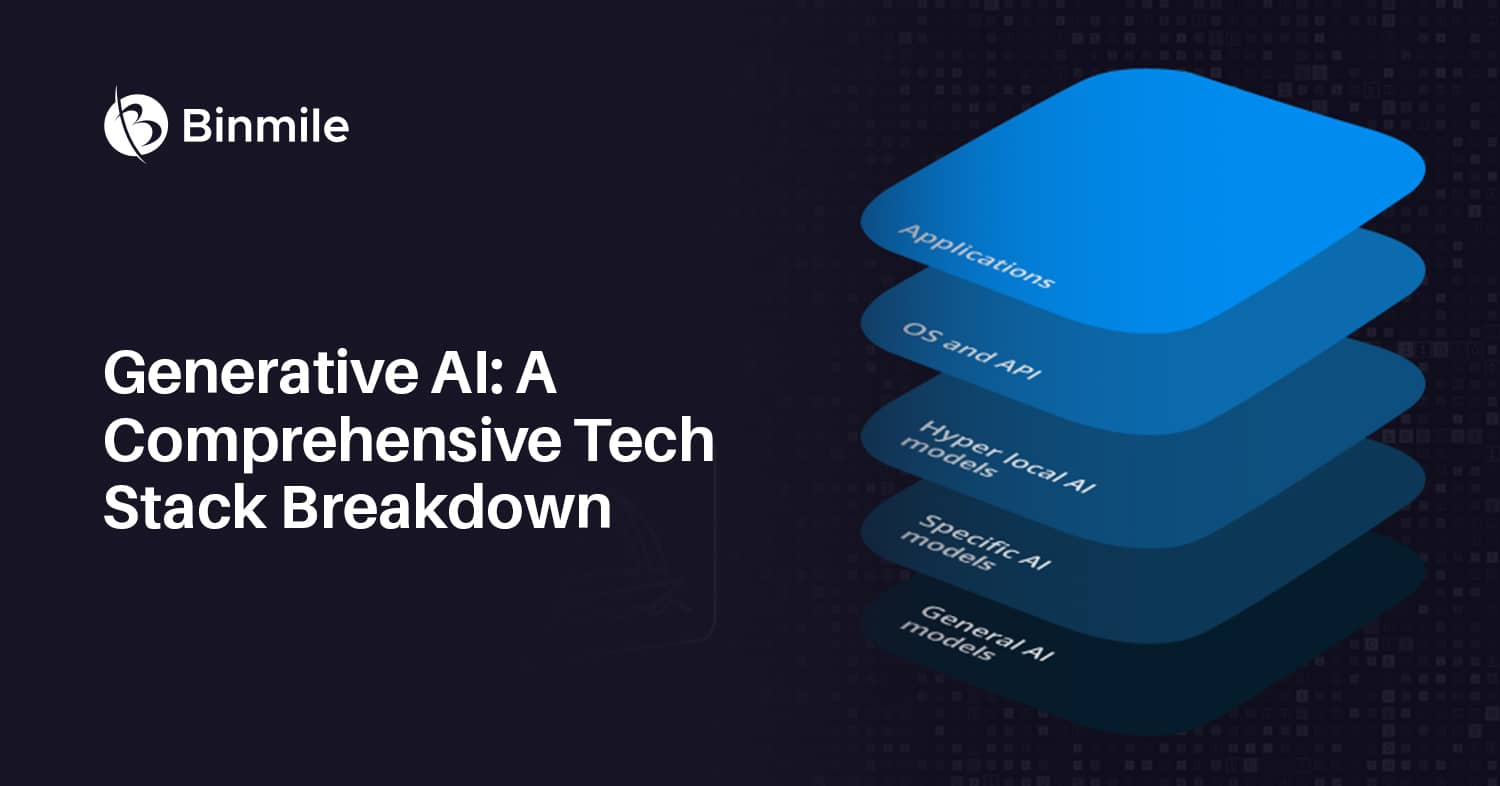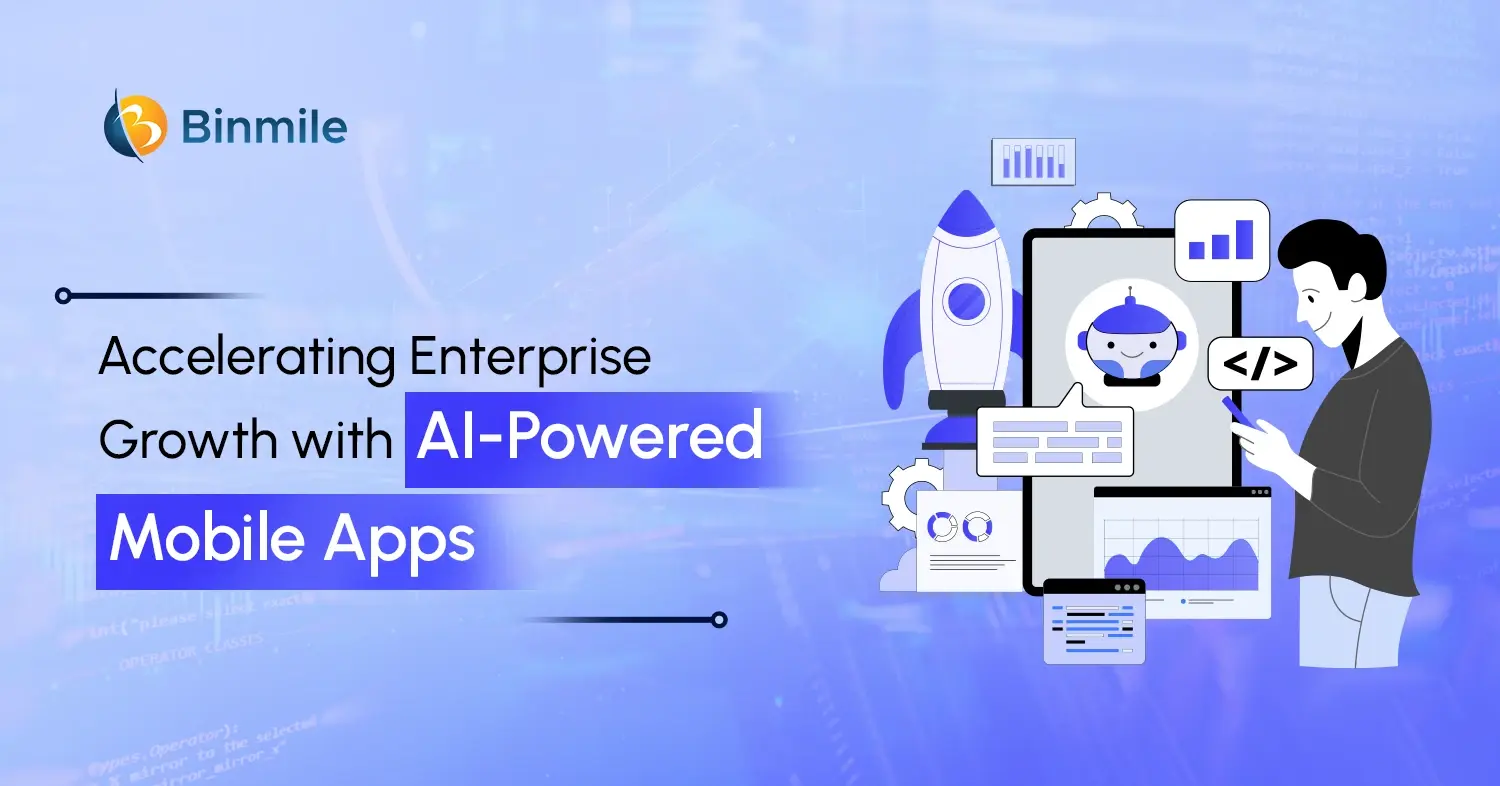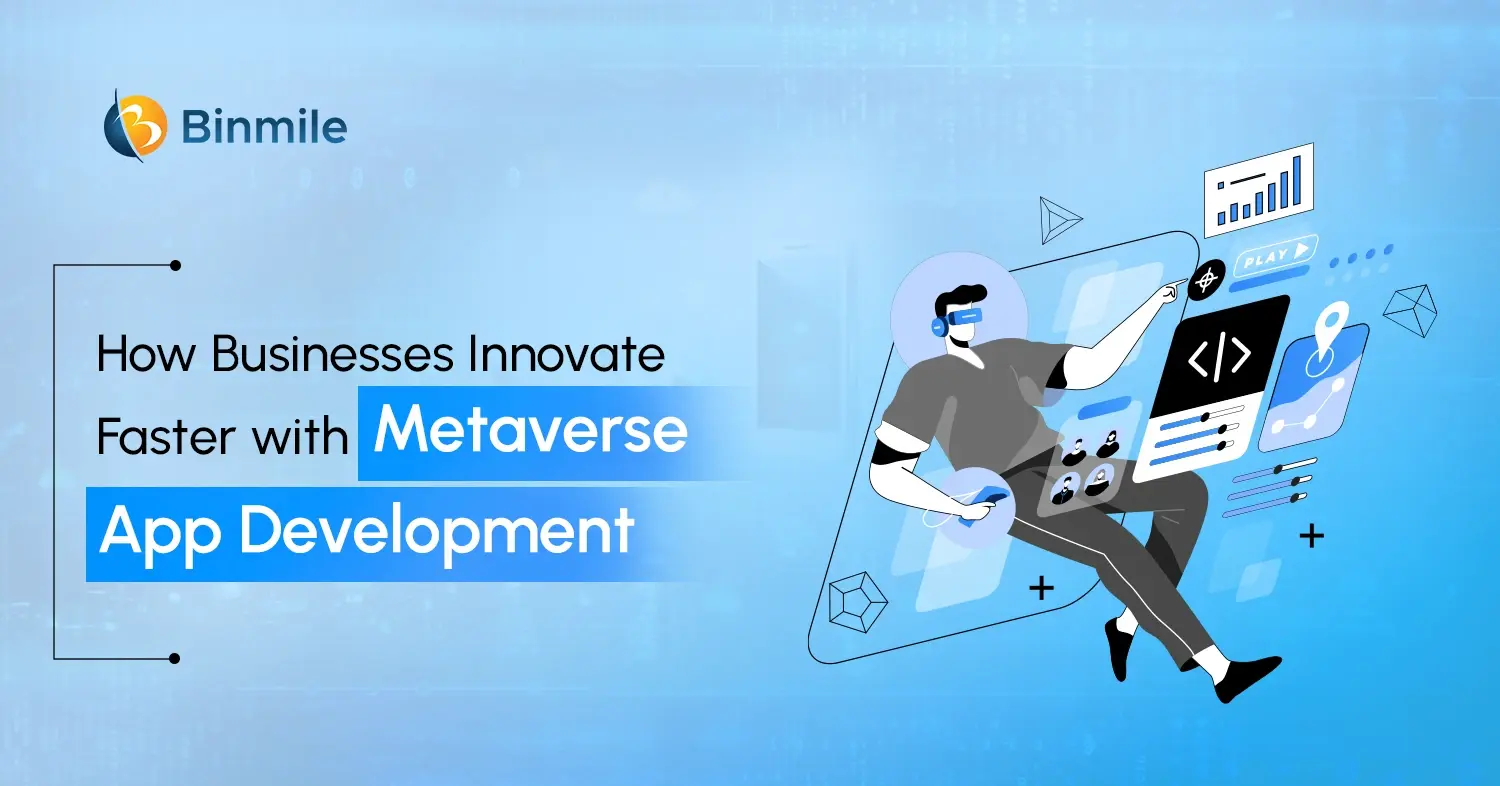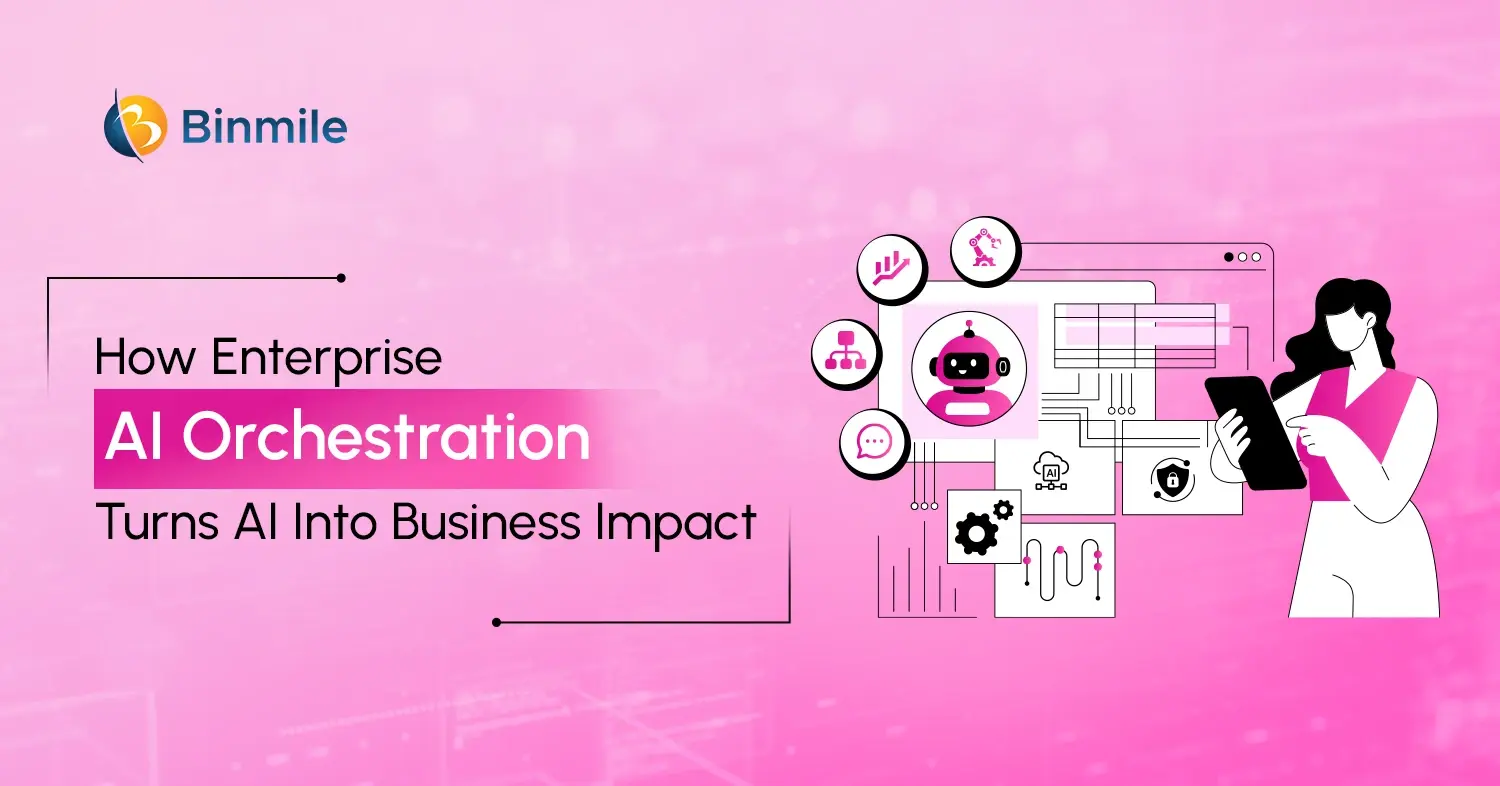- Artificial Intelligence
- components of genai tech stack
- Custom Software Development
- custom software development company
- custom software development serivices
- how to define generative ai
- key consideration of generative ai tech stack
- layers of generative ai tech stack
- reason to choose generative ai tech stack
- technology stack for generative ai
- What are the layers of generative AI?
- What Defines Generative AI Systems?
- What is generative AI tech stack?
- what is generative ai?
Generative AI tech stack refers to technological aspects of generative or creative artificial intelligence. As far as generative AI technology is concerned, it has catapulted its popularity into the mainstream. Its global adoption is taking an upward trend. The official release of ChatGPT and its subsequent massive popularity worldwide have underscored the power of generative AI and Generative AI software development as an innovative content generation medium.
A new tech frontier in generating compelling content based on prompts, the groundbreaking generative artificial intelligence has reportedly exceeded $2 billion in 2022. There has been growing interest from corporations and investors in futuristic generative AI. The Wall Street Journal has reported that OpenAI is in talks to sell shares at a $29 billion valuation, making it one of the most valuable startups in the U.S.
What Is Generative AI? What Defines Generative AI Systems?
Generative AI is a technical concept dedicated to the subfield of artificial intelligence. Generative AI software development is capable of generating compelling content based on data inputs from the users. The ability of the technology to execute content generation is based on the intensive training it goes through on a huge dataset.
A term called generative modeling in generative artificial intelligence learns the patterns within the large dataset using statistical algorithms. Based on the learned patterns and relationships within the dataset, it generates new content. As part of artificial intelligence, generative AI models observantly learn the patterns in the data using neural networks. It leverages different learning approaches, including supervised, unsupervised, and semi-supervised learning.
As far as generative AI systems are concerned, they are defined as a category falling under machine learning. An example of the system is ChatGPT. Due to the advancements in natural language processing, these systems are getting more powerful.
They can turn raw data, like images or texts into the desired outcome (i.e. written sentences and speech). They require just data inputs posing as a plain language prompt of a few sentences to translate them into the desired outcomes.
Read Also: What is the Difference Between Generative Ai and Predictive Ai
The Role Of Comprehensive Tech Stack In Building Generative AI System
Technically speaking, a tech stack consists of a broad range of technologies, frameworks, and tools. Developers use them to build creative software solutions. So, the tech stack is crucial in the context of developing Generative AI software as a powerful system containing key components, such as –
- Machine learning
- Frameworks
- Programming languages
- Cloud infrastructure
- Data processing tools
The role of the generative AI tech stack is extremely valuable. It enhances significantly the system’s accuracy, scalability, and reliability. This, in turn, enables rapid development and deployment of generative AI apps.
Read More: How to Build a Generative AI Solution
Breakdown Of Components In Generative AI Tech Stack
Machine Learning Frameworks
Machine learning frameworks and tools find their applications among data scientists and engineers. They use it to develop Generative AI software with protection-ready models without digging into the principle of ML algorithms. These algorithms favor the use of computational methods based on which they learn information from data. It doesn’t have to rely on a predetermined equation as a model.

It is worth noting that no generative AI system can create new data without the complex development of machine learning models.
List of machine learning frameworks
- TensorFlow
- PyTorch
- Keras
- MXNet
- Caffe
- Theano
- Shogun
Building and training the models involves the use of machine learning frameworks containing an important set of tools and APIs. It also involves different types of pre-built models to generate images, text, and musical notes. ML frameworks ensure flexible designing and customization of the models for an increased level of accuracy and quality.
Programming Languages
Python is the most popular programming language in machine learning. It is an ideal choice for developing generative AI systems. That’s because Python is famous for its simplicity, readability, and extensive library support.
Also Read: Python Frameworks for Web Development
Data Processing Tools
You can’t imagine creating a generative AI system without data. Therefore, raw data requires preprocessing, cleaning, and transformation before being okayed as training data for the models. Apache Spark and Apache Hadoop are some of the most common data processing tools in the AI tech stack. It ensures the efficient handling of large datasets. These data processing tools help developers explore visualization and capabilities of data to understand it and identify patterns.
Cloud Infrastructure
The role of cloud infrastructure in building generative AI systems is quite immense. For instance, it can sort out problems related to storage capacity and massive amounts of computing power that the systems require to train and run the models. Popular options in this context include AWS (Amazon Web Services), Microsoft Azure, and Google Cloud Platform. These Cloud service providers offer a plethora of services, including virtual machines, storage, and ML platforms.
Don’t Miss This: Benefits of AI in Inventory Management

Five Sections of Generative AI Tech Stack
- Basic AI Models: They are versatile models that can work on numerous outputs. For example, GPT-3 for textual results, and DALL-E-2 for visual outputs.
- Specialized AI Models: The purpose it serves is to finetune targeted analytics. They perform better using refined datasets. These models are capable of processing scenarios with the utmost accuracy compared to general models.
- Hyperlocal AI Models: They are designed to create scientific texts in a particular style. Other application areas include designing internal settings based on client’s preferences,
- OS and API Tier: Linking both AI systems and process applications, this layer handles tasks, such as user identity, payments, contracts, terms of service, and storage.
- Apps Layer: They are programmed layers to facilitate the availability of AI models for consumers and businesses.
Also Read: How to Build Generative AI Solution
A Comprehensive Rundown on Generative AI Tech Stack
1. Application Layer
It is one of the most imperative segments of the generative AI tech stack, enabling collaboration between humans and machines. The viability of the application layer is substantial, in the context of generating innovative outcomes, irrespective of boosting business productivity or seeking unique forms of entertainment. The application layer in the field of the AI tech stack is a gateway to unlocking the full potential of the technology.
2. Model layer
The model layer of the generative AI tech stack encompasses open-source checkpoints or proprietary APIs powering AI applications. Deployment of this layer is facilitated through a hosting solution.
3. Infrastructure layer
It consists of hardware and software components used to create and train AI models. Hardware components could refer to GPUs or TPUs (Tensor Processing Units). They are the specialized processors for handling complex computations necessary for AI training and interface. Moreover, these powerful processors allow developers to process massive amounts of faster and more efficiently. Once combined with storage systems, they can store and retrieve massive amounts of data effectively. The infrastructure layer has also another part called cloud computing services, helping companies with instant access to computing resources and storage capacity.
Read Also: Iaas vs Paas vs Saas
What To Consider When Choosing A Generative AI Tech Stack
Consider Project Specifications
Consider the size and goal related to your project. The complexity and extensivity of your AI stack depend largely on the degree of its importance. Medium and large projects would require a more complex AI stack having different levels of programming languages and frameworks. As a result, it will ensure the integrity and performance of the projects.
Key Points To Consider:
- Mind the quality and type of data you want to generate. It will accordingly impact your selection of generative AI techniques.
- Consider the complexity of the project, like the number of input layers, the number of layers in the model, the size of the dataset, etc. A project’s complexity is essential to consider, given complex projects consume more powerful hardware resources, like GPUs, and advanced frameworks, like PyTorch.
- See if your project requires scalability, like creating a large number of variations or supporting multiple users. Under such circumstances, choose an AI tech stack that can scale easily. For example, you may go for AWS or Azure.
- The accuracy of data is a major consideration for the model. In situations, like drug discovery or autonomous driving, the accuracy of data plays a substantial role in determining the selection of the right generative AI tech stack.
Experience And Resources
When it comes to choosing the right generative AI tech stack for AI software development services, having profound technical and architectural knowledge is essential. Developers should be able to differentiate between various technologies and choose the specific ones conducive to creating an AI tech stack.
Why Do Experience and Resources Matter?
- If your development team is experienced and aware of the AI tech stack, like specific programming languages or frameworks, it will come in handy for you. For example, the team will choose the AI tech stack under their experience and expertise. As a result, it will lead to expediting the development of generative AI software.
- The choice of technology also depends on the availability of resources, such as hardware and software. For example, access to powerful hardware, like GPUs will enable your development team to consider choosing more advanced frameworks, like PyTorch to build an AI system.
- Training and support resources also matter in the context of enabling your custom software development team to effectively use a particular tech.
- The budget also comes into the picture when determining what AI tech stack is used. Using a more advanced framework and hardware could pan out an expensive outlay. Choose the AI tech stack that can cost-effectively meet your project’s needs.
- Maintenance and support requirements also render measurable impacts on your choice of generative AI tech stack. Therefore, consider the one to maintain easily and comes with a trusted support community.
Read More: Tech Stack for Mobile App Development
Scalability
The scalability of an application’s architecture is very important, as it ensures that it can handle an increased load. Ensure that your AI tech stack features both horizontal and vertical scaling types. The first one means the ability of the AI tech stack to handle increasing traffic of users from multiple devices. The second one means that necessary features and elements can be added to the application in the future.
Scalability in generative AI tech stack depends on the following considerations –
- The size of the datasets, as the larger ones require more powerful hardware and software.
- The volume of inbound traffic interacting with the system. An AI tech stack must be able to handle a high volume of requests.
- Scalability in apps matters to handle real-time processing of the volume of requests.
- In scenarios where the system can handle large-scale batch processing.
Security
You can’t imagine the safety and health of your tech stack without ensuring robust security in place. That said, choosing high-security technologies matters significantly when selecting a generative AI tech stack.
Reasons why security can influence the choice of technology
- We know that generative AI requires large training datasets. Some data could pertain to sensitive information as well. Therefore, choosing the tech stack featuring built-in security, such as encryption and access controls is wise. It will ensure the mitigation of the risks associated with data breaches.
- Security is important to protect models used in generative artificial intelligence systems from theft or unauthorized access. It is also necessary to protect the system’s infrastructure from unauthorized access or cyber-attacks.
Must Read: Innovative Developments in AI
Conclusion
The role of generative AI is substantial for every organization worldwide that uses artificial intelligence in its business operations. However, the full potential of generative artificial intelligence models can only be utilized to attain desired outcomes if organizations use and implement relevant tech stack for their software development project. For example, businesses can automate routine tasks to generate customized outputs aligning with specific business needs. an AI tech stack implemented well can result in streamlined workflow in businesses. moreover, it will benefit in terms of reducing costs and improving efficiency.
Companies implementing tech stack can also make use of vital components like specialized processors, cloud computing, and storage systems. These components are necessary to build, train, and deploy ethical ai models at scale. As business landscapes are getting more competitive, companies utilizing the full potential of generative artificial intelligence are more likely to stay ahead of the curve than those that are slow in the adoption of such cutting-edge technologies. It means increasing the importance of generative AI software development from a world-renowned software development company.
As a result, organizations trying to stay ahead of the curve in their niche can leverage the power of the technologies to materialize the dream. Binmile stands as a qualified development partner for your needs regarding AI-powered apps based on relevant AI tech stack. We have a team of engineers profoundly experienced and expert in generative AI tech stack. Call us now to steer ahead your business to the future of generative artificial intelligence.
Frequently Asked Questions
An AI technology stack is a comprehensive set of technologies, frameworks, and tools that encompasses various AI subfields, including machine learning. In contrast, a machine learning tech stack specifically focuses on technologies and tools used in the development and deployment of machine learning models within the broader AI ecosystem.
The machine learning tech stack is crucial for creating robust AI models. It includes frameworks like TensorFlow, PyTorch, Keras, MXNet, Caffe, and Theano. These frameworks provide tools and APIs for building and training machine learning models, allowing developers to leverage pre-built models and customize them for specific applications.









